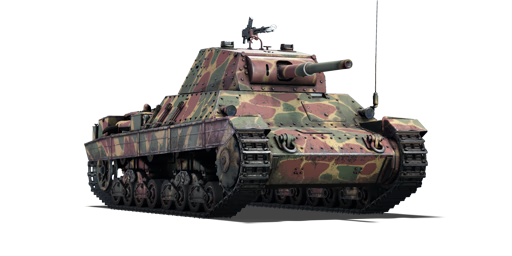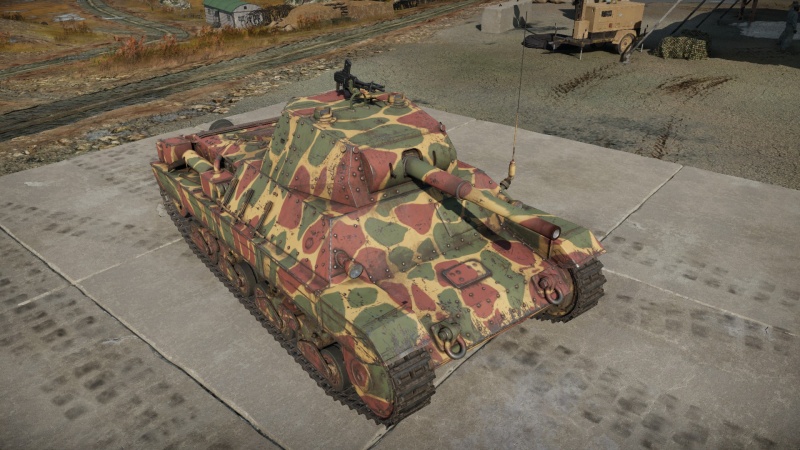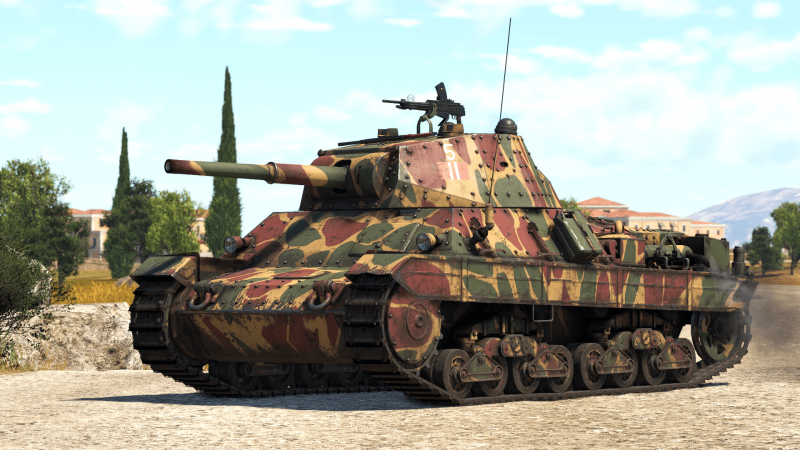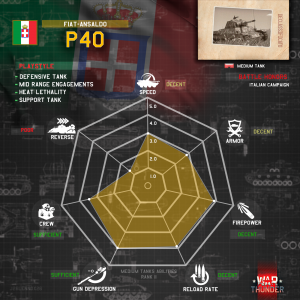Difference between revisions of "P40"
(→Description: Added description) (Tag: Visual edit) |
U136146036 (talk | contribs) (→Ammo racks: Updated ammo rack information since racks 5 and 6 should not be separated.) (Tag: Visual edit) |
||
| (9 intermediate revisions by 4 users not shown) | |||
| Line 14: | Line 14: | ||
== Description == | == Description == | ||
<!-- ''In the description, the first part should be about the history of the creation and combat usage of the vehicle, as well as its key features. In the second part, tell the reader about the ground vehicle in the game. Insert a screenshot of the vehicle, so that if the novice player does not remember the vehicle by name, he will immediately understand what kind of vehicle the article is talking about.'' --> | <!-- ''In the description, the first part should be about the history of the creation and combat usage of the vehicle, as well as its key features. In the second part, tell the reader about the ground vehicle in the game. Insert a screenshot of the vehicle, so that if the novice player does not remember the vehicle by name, he will immediately understand what kind of vehicle the article is talking about.'' --> | ||
| − | At the beginning of 1940, | + | During the war in Africa, the Italians found that their medium and light tanks had a lack of armour and insufficient firepower against the Allied tanks. At the beginning of 1940, they began work on a project for a heavy infantry support tank, which was to fight alongside the medium tanks. The project was initially designated as the P75 for its 75/18 mm cannon, which was later changed to a longer 75/32 gun and finally a 75/34 cannon with better anti-tank capabilities. The initial design derived from the contemporary M13/40 tank, but was later revised with sloped armour plate<ref>"I mezzi blindo-Corazzati Italiani 1923-1943", Nicola Pignato, Storia Militare, Albertelli Edizioni Speciali, Italy, 2007, pp 84-88</ref><ref>"Atlante mondiale dei mezzi corazzati, I carri dell'Asse", Nicola Pignato, Ermanno Albertelli Editore, Italy, 1983, p 64</ref>; eventually the vehicle that came out was the P26/40, a heavy tank by Italian army guidelines due to its weight of 26 tons, and the number 40 for the year of design. The vehicle would only see the battlefield in 1943, of which only 5 would be produced before the armistice and in turn would be captured by the Germans, who would produce a hundred more tanks, many of which were used as fixed emplacements without engine. |
| − | + | Introduced along with the initial Italian ground tree in [[Update 1.85 "Supersonic"]], the P40 proves to be a balanced vehicle between armament, armour, and mobility: between the APCBC and HEAT shells, it is able to penetrate almost every tank it will meet; the mobility is neither too good nor too bad; and the vehicle can take some damage without problems. | |
== General info == | == General info == | ||
| Line 94: | Line 94: | ||
! 4th<br>rack empty | ! 4th<br>rack empty | ||
! 5th<br>rack empty | ! 5th<br>rack empty | ||
| − | |||
! Visual<br>discrepancy | ! Visual<br>discrepancy | ||
|- | |- | ||
| − | | '''63''' || 58 ''(+5)'' || 53 ''(+10)'' || 48 ''(+15)'' || | + | | '''63''' || 58 ''(+5)'' || 53 ''(+10)'' || 48 ''(+15)'' || 42 ''(+21)'' || 1 ''(+62)'' || No |
|- | |- | ||
|} | |} | ||
| − | Sponsons empty: | + | Sponsons empty: 42 ''(+21)'' |
| + | |||
| + | Rack 5 is a massive ammo rack in the hull containing 42 shells. Carrying 21 (+42) effectively reduces its size by half. | ||
=== Machine guns === | === Machine guns === | ||
| Line 159: | Line 160: | ||
<!-- ''Describe the history of the creation and combat usage of the vehicle in more detail than in the introduction. If the historical reference turns out to be too long, take it to a separate article, taking a link to the article about the vehicle and adding a block "/History" (example: <nowiki>https://wiki.warthunder.com/(Vehicle-name)/History</nowiki>) and add a link to it here using the <code>main</code> template. Be sure to reference text and sources by using <code><nowiki><ref></ref></nowiki></code>, as well as adding them at the end of the article with <code><nowiki><references /></nowiki></code>. This section may also include the vehicle's dev blog entry (if applicable) and the in-game encyclopedia description (under <code><nowiki>=== In-game description ===</nowiki></code>, also if applicable).'' --> | <!-- ''Describe the history of the creation and combat usage of the vehicle in more detail than in the introduction. If the historical reference turns out to be too long, take it to a separate article, taking a link to the article about the vehicle and adding a block "/History" (example: <nowiki>https://wiki.warthunder.com/(Vehicle-name)/History</nowiki>) and add a link to it here using the <code>main</code> template. Be sure to reference text and sources by using <code><nowiki><ref></ref></nowiki></code>, as well as adding them at the end of the article with <code><nowiki><references /></nowiki></code>. This section may also include the vehicle's dev blog entry (if applicable) and the in-game encyclopedia description (under <code><nowiki>=== In-game description ===</nowiki></code>, also if applicable).'' --> | ||
[[File:P40 at Army parade.jpg|thumb|P26/40 at an Italian Army parade in 2011]] | [[File:P40 at Army parade.jpg|thumb|P26/40 at an Italian Army parade in 2011]] | ||
| − | The Carro Pesante P26/40 was Italy's | + | The Carro Pesante P26/40 was Italy's heaviest and most modern tank that saw service in WWII. Despite only weighing 26 tonnes, which is significantly less than almost every other country's medium tanks, it was classed as a heavy tank due to Italy's tank design doctrine. |
| + | |||
| + | In early 1940, the Italians started working on a 25 tonne "heavy" infantry support tank that was intended to fight alongside the "M" class medium tanks.<ref>"I mezzi blindo-Corazzati Italiani 1923-1943", Nicola Pignato, Storia Militare, Albertelli Edizioni Speciali, Italy, 2007, pp 84-85</ref> The recent Africa campaign showed the massive problems the Italian tanks in production had, namely a lack of armour and insufficient firepower, prompting the army to make some changes. The initial design of 1941 was based around the same scheme of the M13/40 medium tank and saw the use of a short barrelled 75/18 howitzer in turret, two machine guns in the hull, and the use of vertical armour plates. With the capture of an early T-34/76, displayed by the Germans, the P26/40 was completely revised with sloped plates and a longer 75/34 gun.<ref>"I mezzi blindo-Corazzati Italiani 1923-1943", Nicola Pignato, Storia Militare, Albertelli Edizioni Speciali, Italy, 2007, pp 86</ref> The vehicle was adopted in late 1942 and was named "P26/40", 26 for the weight and 40 for the year it was designed, later simplified to P40 following a new designation policy after August 1942.<ref>"Atlante mondiale dei mezzi corazzati, I carri dell'Asse", Nicola Pignato, Ermanno Albertelli Editore, Italy, 1983, p 10</ref> | ||
| + | |||
| + | While surely better than previous Italian tanks, the P40 was only comparable to mid-war Allied and Soviet medium tanks, such as M4s, Cromwells or T-34/76s, and was still outdated regarding its mobility, the riveted armour and the use of a smaller two-men turret.<ref>"Corazzati 1939/1945", Nicola Pignato, Ermanno Albertelli Editore, Italy, 1974, pp 91-92</ref><ref>"Carri armati nel deserto", Valerio Naglieri, Ermanno Albertelli Editore, Italy, 1972, p 125</ref> The Italian Army considered the use of the heavier, but never realized, P43 and P43 bis, or the license-production of the German Panther even before the service of the P26/40.<ref>"Atlante mondiale dei mezzi corazzati, I carri dell'Asse", Nicola Pignato, Ermanno Albertelli Editore, Italy, 1983, p 66</ref> | ||
| + | |||
| + | Before the Italian Armistice of the 8 September 1943, the Carro Pesante P26/40 was produced in only a few units, between 1 and 5 pre-production vehicles, that were taken by the Wehrmacht when the Italian Army surrendered. The Germans continued production and built around a hundred tanks but due to the low rate of production of the engines and overall modest features of the P40, 38 were used without engine as static emplacements.<ref>"I mezzi blindo-Corazzati Italiani 1923-1943", Nicola Pignato, Storia Militare, Albertelli Edizioni Speciali, Italy, 2007, p 65</ref> Today, two Carro Pesante P26/40s still exist: one of them is in the Museo della Motorizzazione in Rome, while the other one is on display near the Italian Army barracks in Lecce. | ||
== Media == | == Media == | ||
| Line 198: | Line 205: | ||
{{TankManufacturer FIAT-Ansaldo}} | {{TankManufacturer FIAT-Ansaldo}} | ||
{{Italy medium tanks}} | {{Italy medium tanks}} | ||
| + | <references /> | ||
Latest revision as of 18:05, 27 June 2024
| This page is about the Italian medium tank P40. For other uses, see P40 (Disambiguation). For the premium version, see P40 "G.C. Leoncello". |
Contents
Description
During the war in Africa, the Italians found that their medium and light tanks had a lack of armour and insufficient firepower against the Allied tanks. At the beginning of 1940, they began work on a project for a heavy infantry support tank, which was to fight alongside the medium tanks. The project was initially designated as the P75 for its 75/18 mm cannon, which was later changed to a longer 75/32 gun and finally a 75/34 cannon with better anti-tank capabilities. The initial design derived from the contemporary M13/40 tank, but was later revised with sloped armour plate[1][2]; eventually the vehicle that came out was the P26/40, a heavy tank by Italian army guidelines due to its weight of 26 tons, and the number 40 for the year of design. The vehicle would only see the battlefield in 1943, of which only 5 would be produced before the armistice and in turn would be captured by the Germans, who would produce a hundred more tanks, many of which were used as fixed emplacements without engine.
Introduced along with the initial Italian ground tree in Update 1.85 "Supersonic", the P40 proves to be a balanced vehicle between armament, armour, and mobility: between the APCBC and HEAT shells, it is able to penetrate almost every tank it will meet; the mobility is neither too good nor too bad; and the vehicle can take some damage without problems.
General info
Survivability and armour
Armour type:
- Rolled homogeneous armour
- Structural steel
| Armour | Front (Slope angle) | Sides | Rear | Roof |
|---|---|---|---|---|
| Hull | 50 mm (45°), 30 mm (78°), 45 mm (45°) Front glacis 50 mm (38°) Lower glacis 74 mm (45°) Driver's hatch |
45 mm (35°) Top 40 mm Bottom |
40 mm Fighting compartment rear 40 mm (10-40°) |
45 mm Front 15 mm Rear |
| Turret | 50 mm (20°) Turret front 48 + 48 mm (1-78°) Gun mantlet |
45 mm (25-26°) | 45 mm Top 23 + 50 + 45 mm Turret bustle |
20 mm |
Notes:
- Suspension wheels are 15 mm thick, bogies are 10 mm thick, and tracks are 20 mm thick.
- 4 mm side skirts line up parts of the bottom side hull.
- Belly armour is 14 mm thick.
Its protection is enough for most medium-ranged engagements but is able to be easily penetrated by most guns at close range. The front plate is a 50 mm plate sloped at 45° allowing for 65-67 mm of total protection, and the drivers hatch on the left side is 76 mm also sloped at 45° allowing for nearly 100 mm of protection. Most shots to the upper glacis won't penetrate thanks to the radical sloping angle of the plate offering 95 mm of armour, but it is possible for it to deflect a shot into the UFP. The gun mantlet is very well protected, with two rounded plates, which each offer roughly 50 mm of protection, stacked on top of each other allowing for a total of 100 mm. Be wary that the turret is a very vulnerable spot due to the nearly flat plate that only has 50 mm of armour.
Mobility
| Game Mode | Max Speed (km/h) | Weight (tons) | Engine power (horsepower) | Power-to-weight ratio (hp/ton) | |||
|---|---|---|---|---|---|---|---|
| Forward | Reverse | Stock | Upgraded | Stock | Upgraded | ||
| Arcade | Expression error: Unexpected * operator. | 511 | Expression error: Unexpected round operator. | __.__ | |||
| Realistic | 292 | Expression error: Unexpected round operator. | __.__ | ||||
Mobility is below average for the rank but is faster than some common tanks like the early Sherman's and Chi-Nu. However, almost every other tank in the rank will easily outrun the P40 (such as the early T-34s, Cromwells, Pz.III and the Pz.IV F2). The tank's off road speed is quite good, able to reach 43 km/h (27 mph) on dirt and get to that speed quite quickly. The hull traverse is also very good and the tank is very responsive while in motion, allowing for a very mobile playstyle.
Modifications and economy
Armaments
Main armament
The P40 is armed with a Ansaldo 75 L/34, able to carry a total of 63 shells. combining a decent reload with flexible munitions. The P40 has access to a 75 mm APHE round with 79 mm of penetration and a HEAT round with 100 mm of penetration. It is worth noting, either ammunition is usable, but a mix is preferable. Most enemies will easily fall prey to the APHE round, but T-34s, M4 Shermans, and KV-1s, are all enemies that require heavier hitting rounds, like the HEAT round. Note turret rotation is mediocre, and traversing the hull is necessary during close range engagements. The average round velocity will make longer-range combat difficult and the penetration drop off of the APHE round becomes quite noticeable.
| 75 mm Ansaldo 75 L/34 | Turret rotation speed (°/s) | Reloading rate (seconds) | |||||||||||
|---|---|---|---|---|---|---|---|---|---|---|---|---|---|
| Mode | Capacity | Vertical | Horizontal | Stabilizer | Stock | Upgraded | Full | Expert | Aced | Stock | Full | Expert | Aced |
| Arcade | 63 | -10°/+23° | ±180° | N/A | 13.3 | 18.4 | 22.4 | 24.8 | 26.4 | 6.50 | 5.75 | 5.30 | 5.00 |
| Realistic | 8.3 | 9.8 | 11.9 | 13.2 | 14.0 | ||||||||
Ammunition
| Penetration statistics | |||||||
|---|---|---|---|---|---|---|---|
| Ammunition | Type of warhead |
Penetration @ 0° Angle of Attack (mm) | |||||
| 10 m | 100 m | 500 m | 1,000 m | 1,500 m | 2,000 m | ||
| Granata Perforante 75/32 | APCBC | 79 | 78 | 71 | 64 | 58 | 52 |
| EPS M42 | HEAT | 100 | 100 | 100 | 100 | 100 | 100 |
| Granata 75/32 | HE | 10 | 10 | 9 | 9 | 9 | 9 |
| Shell details | ||||||||||||
|---|---|---|---|---|---|---|---|---|---|---|---|---|
| Ammunition | Type of warhead |
Velocity (m/s) |
Projectile mass (kg) |
Fuse delay (m) |
Fuse sensitivity (mm) |
Explosive mass (TNT equivalent) (g) |
Ricochet | |||||
| 0% | 50% | 100% | ||||||||||
| Granata Perforante 75/32 | APCBC | 637 | 6.35 | 1.2 | 14 | 270 | 48° | 63° | 71° | |||
| EPS M42 | HEAT | 552 | 5.3 | 0.05 | 0.1 | 656.64 | 62° | 69° | 73° | |||
| Granata 75/32 | HE | 552 | 6.35 | 0.2 | 0.1 | 600 | 79° | 80° | 81° | |||
Ammo racks
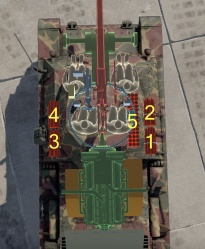
| Full ammo |
1st rack empty |
2nd rack empty |
3rd rack empty |
4th rack empty |
5th rack empty |
Visual discrepancy |
|---|---|---|---|---|---|---|
| 63 | 58 (+5) | 53 (+10) | 48 (+15) | 42 (+21) | 1 (+62) | No |
Sponsons empty: 42 (+21)
Rack 5 is a massive ammo rack in the hull containing 42 shells. Carrying 21 (+42) effectively reduces its size by half.
Machine guns
| 8 mm Breda Mod. 38 | ||||
|---|---|---|---|---|
| Mount | Capacity (Belt) | Fire rate | Vertical | Horizontal |
| Pintle | 288 (24) | 600 | -10°/+20° | N/A |
| Coaxial | 288 (24) | 600 | N/A | N/A |
Usage in battles
The P40 is a tank that excels in medium-ranged engagements thanks to its decent armour and adequate gun. Due to the relatively small size and good mobility, it can, however, be played as an ambush tank that can sneak around and plant a shot in the enemy's sides, allowing for an easy elimination because of the large explosive filler in the APCBC shell. Be wary that while the tank's armour may protect against many lower-rank cannons, cannons at equivalent BR (Namely the Pz.IV's long-barrelled cannon) are easily capable of destroying the tank.
Players in the P40 should always be with teammates, as the P40 is easy prey when separated from its team. Stick with the heavier tanks such as the KV-1's, Churchill's and Matilda's, as they can soak up shots and draw attention away from the weak little P40, allowing the player to sneak around and hit a few tanks. If there are no heavy tanks, the P40's best bet is to support a Sherman or Pz.IV, as both of them can deal with enemies that the P40 can't.
Specific enemies worth noting:
- KV-1 (L-11)/KV-1S. These Russian heavy beasts are incredibly difficult for the P40 to deal with, as their armour is able to shrug off even the EPS M42 HEAT round and they mount guns able to punch through it frontally. Your best bet to destroy them solo is by taking out their guns and burn them out by shooting their engine, but if the P40 is accompanied by a tank with a stronger gun such as the long-barrelled Pz.IV's, the engagement will become significantly easier. When accompanied by teammates, take out their gun and tracks in order to ensure a teammate secures the kill.
- Matilda III. The British Matilda tank is the most common enemy the P40 will face, and boasts excellent all-around protection comparable to the previously mentioned KV-1's and an excellent crew layout. It's worth mentioning that its complex side armour is able to thwart the EPS round when not aimed carefully, and has a habit of absorbing shells in general. It is however not without its downfalls, as its main gun has very low penetration across all of its shell selections, with the highest penetrating shell still being unable to penetrate a well-angled P40 at 300 meters out, and it being incredibly slow. Your EPS shell can penetrate the turret sides at most ranges and will take out all 3 crew members in the turret when aimed carefully.
Pros and cons
Pros:
- Decent frontal armour
- The gun possesses satisfactory performance at its rank
- Has access to HEAT shells with 100 mm of penetration
- Stock shell has a lot of explosive filler, making one-shot very common
- Relatively small for a medium tank
- Very good in medium-ranged performance
- Relatively consistent armour protection all around the tank ~ good for angling
Cons:
- Overall penetration is not that great
- Pitifully low ammo count for each machine gun belt
- Armour can still be penetrated by a few enemies of rank II, most notably by the long-barreled Panzer IVs
- Breda Mod. 38's have a very low magazine count
- Lower than the average speed
- Mediocre turret traverse
- Smoke shells deploy behind the tank
History
The Carro Pesante P26/40 was Italy's heaviest and most modern tank that saw service in WWII. Despite only weighing 26 tonnes, which is significantly less than almost every other country's medium tanks, it was classed as a heavy tank due to Italy's tank design doctrine.
In early 1940, the Italians started working on a 25 tonne "heavy" infantry support tank that was intended to fight alongside the "M" class medium tanks.[3] The recent Africa campaign showed the massive problems the Italian tanks in production had, namely a lack of armour and insufficient firepower, prompting the army to make some changes. The initial design of 1941 was based around the same scheme of the M13/40 medium tank and saw the use of a short barrelled 75/18 howitzer in turret, two machine guns in the hull, and the use of vertical armour plates. With the capture of an early T-34/76, displayed by the Germans, the P26/40 was completely revised with sloped plates and a longer 75/34 gun.[4] The vehicle was adopted in late 1942 and was named "P26/40", 26 for the weight and 40 for the year it was designed, later simplified to P40 following a new designation policy after August 1942.[5]
While surely better than previous Italian tanks, the P40 was only comparable to mid-war Allied and Soviet medium tanks, such as M4s, Cromwells or T-34/76s, and was still outdated regarding its mobility, the riveted armour and the use of a smaller two-men turret.[6][7] The Italian Army considered the use of the heavier, but never realized, P43 and P43 bis, or the license-production of the German Panther even before the service of the P26/40.[8]
Before the Italian Armistice of the 8 September 1943, the Carro Pesante P26/40 was produced in only a few units, between 1 and 5 pre-production vehicles, that were taken by the Wehrmacht when the Italian Army surrendered. The Germans continued production and built around a hundred tanks but due to the low rate of production of the engines and overall modest features of the P40, 38 were used without engine as static emplacements.[9] Today, two Carro Pesante P26/40s still exist: one of them is in the Museo della Motorizzazione in Rome, while the other one is on display near the Italian Army barracks in Lecce.
Media
- Skins
- Videos
- Videos for the P40 "G.C. Leoncello" also apply to the P40.
See also
- Vehicles equipped with the same chassis
- Other vehicles of similar configuration and role
- T-34 (Family) - T-34/76 models
External links
- [Wikipedia] P26/40 tank
- [Tanks Encyclopedia] Carro Armato P26/40
- [Military Factory] Carro Armato P40 (Carro Pesante P40)
| FIAT-Ansaldo | |
|---|---|
| Autoblindo | AB 41 · AB 43 |
| Light Tanks | L6/40 · L6/40 (31 Rgt.) |
| Medium Tanks | Celere Sahariano |
| M11/39 | M11/39 |
| M13/40 | M13/40 (I) · M13/40 (II) · M13/40 (III) |
| M14/41 | M14/41 · M14/41 (47/40) |
| M15/42 | M15/42 |
| P40 | P40 · P40 "G.C. Leoncello" |
| Tank Destroyers | |
| L3/33 | L3/33 CC |
| Semovente L40 | 47/32 L40 |
| Semovente M41 | 75/18 M41 · 75/32 M41 · 90/53 M41M |
| Semovente M42 | 75/34 M42 |
| Semovente M43 | 105/25 M43 · M43 "G.C.Leoncello" · 75/34 M43 · 75/46 M43 |
| SPAAs | M42 Contraereo |
| Italy medium tanks | |
|---|---|
| Italy | |
| M13/40 | M13/40 (I) · M13/40 (II) · M13/40 (III) |
| M14/41 | M14/41 · M14/41 (47/40) |
| M15/42 | M15/42 |
| M16/43 | Celere Sahariano |
| P26/40 | P40 · P40 "G.C. Leoncello" |
| OF-40 | OF-40 · OF-40 Mk.2A · OF-40 (MTCA) |
| Ariete | Ariete (P) · Ariete · Ariete PSO · Ariete AMV |
| Germany | ▄Pz.III N · ▄Pz.IV G · ▄Leopard 1A5 |
| Allied powers | ▄Sherman I Composito · Sherman Ic · ▄Sherman Vc · ▄Sherman V · M26 "D.C.Ariete" · M26A1 · M47 (105/55) · M60A1 "D.C.Ariete" |
| Hungary | |
| Turán | Turan I · Turan II · Turan III |
| Germany | ◔Leopard 2A4 · Leopard 2A7HU |
| USSR | ◔T-72M1 |
- ↑ "I mezzi blindo-Corazzati Italiani 1923-1943", Nicola Pignato, Storia Militare, Albertelli Edizioni Speciali, Italy, 2007, pp 84-88
- ↑ "Atlante mondiale dei mezzi corazzati, I carri dell'Asse", Nicola Pignato, Ermanno Albertelli Editore, Italy, 1983, p 64
- ↑ "I mezzi blindo-Corazzati Italiani 1923-1943", Nicola Pignato, Storia Militare, Albertelli Edizioni Speciali, Italy, 2007, pp 84-85
- ↑ "I mezzi blindo-Corazzati Italiani 1923-1943", Nicola Pignato, Storia Militare, Albertelli Edizioni Speciali, Italy, 2007, pp 86
- ↑ "Atlante mondiale dei mezzi corazzati, I carri dell'Asse", Nicola Pignato, Ermanno Albertelli Editore, Italy, 1983, p 10
- ↑ "Corazzati 1939/1945", Nicola Pignato, Ermanno Albertelli Editore, Italy, 1974, pp 91-92
- ↑ "Carri armati nel deserto", Valerio Naglieri, Ermanno Albertelli Editore, Italy, 1972, p 125
- ↑ "Atlante mondiale dei mezzi corazzati, I carri dell'Asse", Nicola Pignato, Ermanno Albertelli Editore, Italy, 1983, p 66
- ↑ "I mezzi blindo-Corazzati Italiani 1923-1943", Nicola Pignato, Storia Militare, Albertelli Edizioni Speciali, Italy, 2007, p 65


